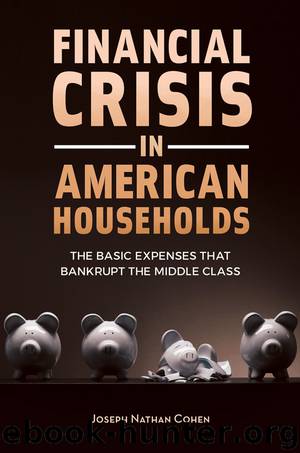Financial Crisis in American Households: the Basic Expenses That Bankrupt the Middle Class by Cohen Joseph Nathan;

Author:Cohen, Joseph Nathan;
Language: eng
Format: epub
Publisher: ABC-CLIO, LLC
Figure 5.2 Mean Household Spending, 1984–2014.
Source: Bureau of Labor Statistics (2015).
Areas of Rising Expenditures
While the prices of consumer products generally fell in proportion to incomes, spending rose in a selected set of product categories. For example, educational and healthcare have risen considerably. These expenditures, which are depicted in the middle of Figure 5.2, rose by almost 80 percent. By comparison, these surveys suggest that real disposable income has risen by about 20 percent during the same period. In addition, these data suggest that housing costs have outpaced income growth. While this difference is less striking than in education and healthcare, the housing expenditure is the largest item in household budgets, so it has an outsized impact on households’ overall spending levels. We will discuss these spending areas in greater detail below.
One tie that binds these three spending areas is that the primary engines of living cost containment—importation and automation—have not succeeded in driving down costs in these markets. The effects of these primary engines of spending may have been compounded by economic policy changes. As we will see in Chapter Seven, the public sector’s presence in U.S. higher education and healthcare is comparatively light relative to other highly developed countries.
Education Costs
Although education costs have risen substantially, their direct impact on the average U.S. household’s overall living costs is limited. The BLS assumes that education costs on average about 3 percent of U.S. households’ overall living costs.20 This is due to the fact that only part of society incurs these costs, and only a minority incurs heavy costs. To develop a clearer sense of the education costs borne by households, we have to drill down past overall inflation figures presented in Figure 5.2 and examine the microdata. We can do so using the BLS Survey of Consumer Finances.21 Unfortunately, high-quality publicly accessible microdata only goes back to 1996, so we are unable to take a close look at the 1980s and early 1990s. However, we can use the data to get a view of what has happened to living costs since the mid-1990s.
The data suggest that, in 2014, only 18 percent of U.S. households incurred educational costs. Most of them incurred limited expenses. Usually, these expenditures involve materials, supplies, or lessons that supplemented the fully socialized primary and secondary educational system in the United States. Among households with any education expenditures, median spending was $750, or about 1.4 percent of their disposable income. Mean spending figures from Figure 5.2 suggest that education costs have been escalating rapidly. This is not the result of a broad-based rise in education spending. The heavy costs were borne by childless households and households with adult children—those who are more likely to be pursuing postsecondary training, where educational costs are not socialized.
The cost of college is considerable, and, as suggested previously in Table 5.1, it has been rising quickly—more than double the rate of overall prices or median wages. In 2015, the average published tuition for in-state students at public universities was $9,410, and the total cost (including supplies, room and board, books, etc.
Download
This site does not store any files on its server. We only index and link to content provided by other sites. Please contact the content providers to delete copyright contents if any and email us, we'll remove relevant links or contents immediately.
The Secret History by Donna Tartt(16623)
The Social Justice Warrior Handbook by Lisa De Pasquale(11489)
Thirteen Reasons Why by Jay Asher(7788)
This Is How You Lose Her by Junot Diaz(5771)
Weapons of Math Destruction by Cathy O'Neil(5036)
Zero to One by Peter Thiel(4824)
The Myth of the Strong Leader by Archie Brown(4789)
Promise Me, Dad by Joe Biden(4447)
Beartown by Fredrik Backman(4417)
Stone's Rules by Roger Stone(4415)
How Democracies Die by Steven Levitsky & Daniel Ziblatt(4398)
The Fire Next Time by James Baldwin(4342)
100 Deadly Skills by Clint Emerson(4076)
A Higher Loyalty: Truth, Lies, and Leadership by James Comey(4032)
Rise and Kill First by Ronen Bergman(4012)
The David Icke Guide to the Global Conspiracy (and how to end it) by David Icke(3881)
The Farm by Tom Rob Smith(3872)
Secrecy World by Jake Bernstein(3782)
The Doomsday Machine by Daniel Ellsberg(3730)
